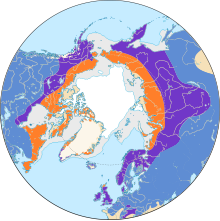| Common redpoll | |
|---|---|

| |
| Male, Quebec Canada | |
| Scientific classification | |
| Domain: | Eukaryota |
| Kingdom: | Animalia |
| Phylum: | Chordata |
| Class: | Aves |
| Order: | Passeriformes |
| Family: | Fringillidae |
| Subfamily: | Carduelinae |
| Genus: | Acanthis |
| Species: | A. flammea
|
| Binomial name | |
| Acanthis flammea | |
| Subspecies | |
| |

| |
| Synonyms | |
| |
The common redpoll or mealy redpoll (Acanthis flammea) is a species of bird in the finch family. It breeds somewhat further south than the Arctic redpoll, also in habitats with thickets or shrubs.
YouTube Encyclopedic
-
1/3Views:1 5142 2271 875
-
Finding Common Redpolls During an Irruption Year
-
Common Redpoll
-
Common Redpoll Irruption: Find These Winter Finches Before They're Gone!
Transcription
Taxonomy
The common redpoll was listed in 1758 by Linnaeus in the 10th edition of his Systema Naturae under the binomial name Fringilla flammea.[2][3] The current genus name Acanthis is from the Ancient Greek akanthis, a name for a small now-unidentifiable bird, and flammea is the Latin for "flame-coloured".[4]
The common redpoll was previously placed in the genus Carduelis. Molecular phylogenetic studies showed that the Arctic and common redpolls formed a distinct lineage, so the two species were grouped together in the resurrected genus Acanthis.[5][6]
Subspecies
The nominate subspecies A. f. flammea, the mealy redpoll, breeds across the northern parts of North America and the Palearctic. There is also a subspecies that breeds in Iceland called the Icelandic redpoll (A. f. islandica), and one that breeds in Greenland and Baffin Island called the Greenland redpoll (A. f. rostrata). Many taxonomic authorities consider the lesser redpoll a subspecies of the common redpoll.[6][7] Together, the Icelandic and Greenland forms are sometimes known as the 'northwestern redpolls'. All the subspecies migrate south into Canada, the northern U.S., or Eurasia. These birds are remarkably resistant to cold temperatures[8] and winter movements are mainly driven by the availability of food. There are two distinct populations (one lighter, one darker) united in islandica, the relationships of which are unresolved.[9]
Description

The common redpoll is a small brownish-grey finch with dark streaks and a bright red patch on its forehead. It has a black bib and two pale stripes on the wings. Males often have their breasts suffused with red. It is smaller, browner and more streaked than the generally similar Arctic redpoll, adults measuring between 11.5 and 14 centimetres (4.5 and 5.5 in) in length and weighing between 12 and 16 grams (0.42 and 0.56 oz). Wingspan ranges from 7.5 to 8.7 in (19-22 cm).[10] The rump is streaked and there is a broad dark brown streak across the vent. It has brown legs, dark-tipped yellowish bills and dark brown irises.[11]
Similar species
The mealy redpoll is larger and paler than the lesser redpoll with which it often mixes, apparently without significant interbreeding, though sympatry was established too recently to draw firm conclusions.[12] The male mealy redpolls are darker than the similarly sized Arctic redpolls, but the females are almost identical.
Behaviour
The range of the common redpoll extends through northern Europe and Asia to northern North America, Greenland and Iceland. It is a partial migrant, moving southward in late autumn and northward again in March and April. Its typical habitat is boreal forests of pines, spruces and larches. It feeds mainly on seeds, principally birch and alder seeds in the winter.[11]
The common redpoll builds its nest low down in a tree or bush. The nest has an outer layer of thin twigs, a middle layer of root fibres, fragments of juniper bark and lichens and an inner layer of down, willow buds and reindeer hair. Three to seven speckled eggs are laid and incubated by the female. They hatch after about 11 days and the young fledge in about a further 13 days.[11]
References

- ^ BirdLife International (2019) [amended version of 2018 assessment]. "Acanthis flammea". IUCN Red List of Threatened Species. 2019: e.T22725044A155292529. doi:10.2305/IUCN.UK.2018-2.RLTS.T22725044A155292529.en. Retrieved 12 November 2021.
- ^ Paynter, Raymond A. Jnr., ed. (1968). Check-list of birds of the world, Volume 14. Cambridge, Massachusetts: Museum of Comparative Zoology. p. 251.
- ^ Linnaeus, C. (1766). Systema Naturæ per regna tria naturae, secundum classes, ordines, genera, species, cum characteribus, differentiis, synonymis, locis, Volume 1 (in Latin) (10th ed.). Holmiae:Laurentii Salvii. p. 182.
- ^ Jobling, James A. (2010). The Helm Dictionary of Scientific Bird Names. London, United Kingdom: Christopher Helm. pp. 29, 160. ISBN 978-1-4081-2501-4.
- ^ Zuccon, Dario; Prŷs-Jones, Robert; Rasmussen, Pamela C.; Ericson, Per G.P. (2012). "The phylogenetic relationships and generic limits of finches (Fringillidae)" (PDF). Molecular Phylogenetics and Evolution. 62 (2): 581–596. doi:10.1016/j.ympev.2011.10.002. PMID 22023825.
- ^ a b Gill, Frank; Donsker, David (eds.). "Finches, euphonias". World Bird List. V13.2. International Ornithologists' Union. Retrieved 22 December 2023.
- ^ BirdLife International. "Redpoll Acanthis flammea". BLI Datasheets.
- ^ "adn.com | Wildlife News : Some birds tougher than winter". Archived from the original on 2008-04-02. Retrieved 2008-02-21.
- ^ Seutin, G.; Ratcliffe, L. M. & Boag, P. T. (1995) Mitochondrial DNA homogeneity in the phenotypically diverse redpoll finch complex (Aves: Carduelinae: Carduelis flammea - hornemanni). Evolution 49(5): 962–973. doi:10.2307/2410418 (HTML abstract and first page image)
- ^ "Common Redpoll Identification, All About Birds, Cornell Lab of Ornithology". www.allaboutbirds.org. Retrieved 2020-09-29.
- ^ a b c "Redpoll: Carduelis flammea". NatureGate. Retrieved 2013-12-13.
- ^ Sangster, George; Knox, Alan G.; Helbig, Andreas J.; Parkin, David T. (2002). "Taxonomic recommendations for European birds". Ibis. 144 (1): 153–159. doi:10.1046/j.0019-1019.2001.00026.x.
External links
- Audio recordings from Xeno-canto
- Oiseaux.net Photos
- Common Redpoll Species Account – Cornell Lab of Ornithology
- "Common redpoll media". Internet Bird Collection.
- Common redpoll photo gallery at VIREO (Drexel University)
- Feathers of Common Redpoll (Carduelis flammea) Archived 2018-03-04 at the Wayback Machine
- Interactive range map of Carduelis flammea at IUCN Red List maps

